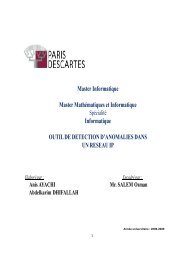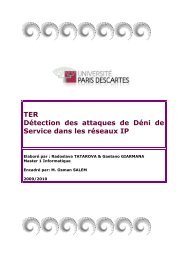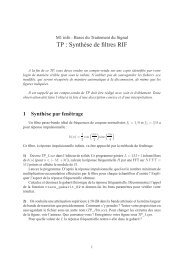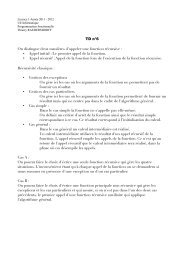Th`ese de Doctorat de l'université Paris VI Pierre et Marie Curie Mlle ...
Th`ese de Doctorat de l'université Paris VI Pierre et Marie Curie Mlle ...
Th`ese de Doctorat de l'université Paris VI Pierre et Marie Curie Mlle ...
Create successful ePaper yourself
Turn your PDF publications into a flip-book with our unique Google optimized e-Paper software.
per-flow bandwidth guarantee and then exploits the unused bandwidth individuated peri-<br />
odically in the n<strong>et</strong>work to propose short-term guaranteed extra-bandwidth to users who<br />
are willing to pay more to g<strong>et</strong> a higher bandwidth. To implement our service mo<strong>de</strong>l, we<br />
introduced a distributed dynamic resource provisioning architecture for quality of service<br />
n<strong>et</strong>works and a s<strong>et</strong> of control messages to provi<strong>de</strong> interactions b<strong>et</strong>ween n<strong>et</strong>work elements.<br />
In Chapter 4, we presented a precise statement of the bandwidth allocation problem,<br />
then we provi<strong>de</strong>d a utility-based <strong>de</strong>finition of the n<strong>et</strong>work extra-revenue and finally we<br />
performed a connections classification based on traffic statistics gathered at ingress routers.<br />
In Chapter 5, we proposed a broad s<strong>et</strong> of heuristic dynamic bandwidth allocation algorithms<br />
tailored to our proposed service mo<strong>de</strong>l, with increasing complexity and performance.<br />
In Chapter 6, we introduced a novel mathematical mo<strong>de</strong>l that assumes the exact knowl-<br />
edge of the future traffic offered to the n<strong>et</strong>work and extends the well known utility max-<br />
imization problem studied in [7] to inclu<strong>de</strong> connections arrival-times and durations. Our<br />
mo<strong>de</strong>l allows to provi<strong>de</strong> bounds to the performance achievable by any online dynamic<br />
bandwidth allocation algorithm.<br />
Simulation results in Chapter 7 measured in realistic n<strong>et</strong>work scenarios showed that<br />
our allocation algorithms and service mo<strong>de</strong>l allow to increase both resource utilization and<br />
n<strong>et</strong>work revenue with respect to static provisioning techniques. Further, in Chapter 8,<br />
we compared the performance of our bandwidth allocation algorithms to the bounds pro-<br />
vi<strong>de</strong>d by the mathematical mo<strong>de</strong>l. We have shown that these algorithms allow to increase<br />
consistently n<strong>et</strong>work revenue with respect to static provisioning schemes and approach, in<br />
several n<strong>et</strong>work scenarios, the upper bound provi<strong>de</strong>d by the mathematical mo<strong>de</strong>l.<br />
9.2 Future Research Issues<br />
In this thesis we have addressed the problem of dynamic bandwidth allocation consi<strong>de</strong>ring<br />
a fixed routing strategy. We have assumed that each communication b<strong>et</strong>ween a user pair is<br />
84










